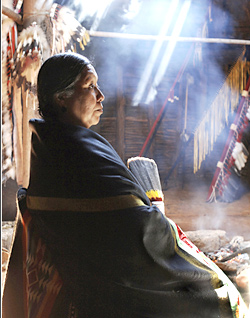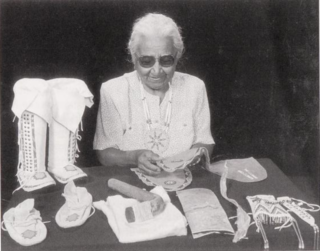Related Research Articles

Beadwork is the art or craft of attaching beads to one another by stringing them onto a thread or thin wire with a sewing or beading needle or sewing them to cloth. Beads are produced in a diverse range of materials, shapes, and sizes, and vary by the kind of art produced. Most often, beadwork is a form of personal adornment, but it also commonly makes up other artworks.

The Institute of American Indian Arts (IAIA) is a public tribal land-grant college in Santa Fe, New Mexico, United States. The college focuses on Native American art. It operates the Museum of Contemporary Native Arts (MoCNA), which is housed in the historic Santa Fe Federal Building, a landmark Pueblo Revival building listed on the National Register of Historic Places as Federal Building. The museum houses the National Collection of Contemporary Indian Art, with more than 7,000 items.
The Oklahoma City – Ada – Atoka Railway (OCAA) was formed from trackage from Oklahoma City to Atoka via Shawnee, Ada, and Coalgate, Oklahoma. Atoka to Coalgate had been built between 1882 and 1886 as feeder to the old Missouri–Kansas–Texas Railroad (Katy) main line, and Coalgate-Shawnee-Oklahoma City had been constructed by Katy affiliates, and specifically the first 40 miles northwest out of Coalgate having been built by the Texas and Oklahoma Railroad in 1902. The remaining 78 miles into Oklahoma City were built in the 1903-1904 timeframe by that line’s successor, the Missouri, Kansas and Oklahoma Railroad Company. These properties were not included in the 1923 reorganization of the Katy, and were put in the OCAA instead. The OCAA was sold to the Muskogee Company in 1929, becoming one of the Muskogee Roads.

Juanita Growing Thunder Fogarty is a Native American, Assiniboine Sioux bead worker and porcupine quill worker. She creates traditional Northern Plains regalia.
Teri Greeves is a Native American beadwork artist, living in Santa Fe, New Mexico. She is enrolled in the Kiowa Indian Tribe of Oklahoma.

Marcus Amerman is a Choctaw bead artist, glass artist, painter, fashion designer, and performance artist, living in Idaho. He is known for his highly realistic beadwork portraits.

Vanessa Paukeigope Santos Jennings is a Kiowa/Kiowa Apache/Gila River Pima regalia maker, clothing designer, cradleboard maker, and beadwork artist from Oklahoma.

Richard Aitson was a Kiowa-Kiowa Apache bead artist, curator, and poet from Oklahoma.

Norma "Nana" Howard (1958–2024) was a Choctaw-Chickasaw Native American artist from Stigler, Oklahoma, who painted genre scenes of children playing, women working in fields, and other images inspired by family stories and Choctaw life. Howard won her first art award at the 1995 Red Earth Native American Cultural Festival in Oklahoma City. Her work is popular with collectors and critics.
Jamie Okuma is a Native American visual artist and fashion designer from California. She is known for beadwork, mixed-media soft sculpture, and fashion design. She is Luiseño, Wailaki, Okinawan, and Shoshone-Bannock. She is also an enrolled member of the La Jolla band of Indians in Southern California where she is currently living and working.

Josephine Myers-Wapp was a Comanche weaver and educator. After completing her education at the Haskell Institute, she attended Santa Fe Indian School, studying weaving, dancing, and cultural arts. After her training, she taught arts and crafts at Chilocco Indian School before joining the faculty of the newly opened Institute of American Indian Arts in Santa Fe. She taught weaving, design, and dance at the institute, and in 1968 was one of the coordinators for a dance exhibit at the Mexican Summer Olympic Games. In 1973, she retired from teaching to focus on her own work, exhibiting throughout the Americas and in Europe and the Middle East. She has work in the permanent collection of the IAIA and has been featured at the Smithsonian Institution. Between 2014 and 2016, she was featured in an exhibition of Native American women artists at the Museum of Indian Arts and Culture in Santa Fe.

Jeri Ah-be-hill was a Kiowa fashion expert and art dealer. She owned and operated a trading post on the Wind River Indian Reservation for more than twenty years before moving to Santa Fe, New Mexico where she became the curator of the annual Native American Clothing Contest held at the Santa Fe Indian Market. She also worked as a docent at both the Institute of American Indian Arts and the Wheelwright Museum of the American Indian. Considered an expert on Native American fashion, she traveled nationally presenting educational information about tribal clothing.

Native American fashion is the design and creation of high-fashion clothing and fashion accessories by Native Americans in the United States. This is a part of a larger movement of Indigenous fashion of the Americas.
Margaret Roach Wheeler is a Chickasaw/Choctaw weaver and Native American fashion designer. Her work has been widely recognized for her scholarship in researching designs and techniques which existed prior to conquest and incorporating design elements into her woven garments. Her work has been featured in numerous collections including the Smithsonian's National Museum of the American Indian, where she has also served as a visiting artist and received a research fellowship. She was inducted into the Chickasaw Nation Hall of Fame in 2010 and was honored by the State of Oklahoma with the Governor's Arts Award in 2018 for her unique contributions to art. She is the founder of Mahota Textiles.

Jackie Larson Bread is a Native American beadwork artist from the Blackfeet Reservation in Browning, Montana. Her interest in bead work was sparked from looking at her late-grandmother's beaded pieces. In awe of these objects, Bread self-taught herself how to bead when she was younger and now, she has been beading for more than 20 years. Continuing through trial and error, Bread has received numerous awards for her beading.

Joyce Growing Thunder Fogarty, is a Native American artist. She is of the Assiniboine Sioux, Dakota people, and is known for her beadwork and quillwork. She creates traditional Northern Plains regalia. The Smithsonian named her as "one of the West's most highly regarded beadworkers".
TahneeAhtoneharjo-Growingthunder, is a Kiowa beadwork artist, regalia maker, curator, and museum professional of Muscogee and Seminole descent, from Mountain View, Oklahoma.

Sandy Fife Wilson is a Muscogee (Creek) art educator, fashion designer and artist. After graduating from the Institute of American Indian Arts and Northeastern Oklahoma State University, she became an art teacher, first working in the public schools of Dewey, Oklahoma. When Josephine Wapp retired as the textile instructor at the Institute of American Indian Arts, Wilson was hired to teach the design courses. After three years, in 1979, she returned to Oklahoma and taught at Chilocco Indian School until it closed and then worked in the Morris Public School system until her retirement in 2009.

Alice Littleman was a Kiowa beadwork artist and regalia maker, who during her lifetime was recognized as one of the leading Kiowa beaders and buckskin dressmakers. Her works are included in the permanent collections of the National Museum of Natural History, the National Museum of the American Indian, the Southern Plains Indian Museum, and the Oklahoma Historical Society.
Katrina Mitten is a Native American artist. She is enrolled in the Miami Tribe of Oklahoma.
References
- 1 2 McDonnell, Brandy (June 5, 2014). "Former basketball coach turned beadwork artist named Honored One of Red Earth Festival, which starts TONIGHT". NewsOK. Retrieved 7 May 2015.
- ↑ "Atoka Alumni Hall of Fame 2014: Les Berryhill". YouTube. Retrieved 20 April 2015.
- 1 2 3 McDonnell, Brandy (May 25, 2014). "Red Earth Honored One Turns Tiny Beads Into Bold Artwork". The Oklahoman. Retrieved 20 April 2015.
- 1 2 3 "Oklahoma Higher Education's Campus E-Clips Newsletter". September 17, 2003. Retrieved 20 April 2015.
- 1 2 3 4 Pearson-Little Thunder, Julie (September 20, 2012). "Oral History Interview with Les Berryhill". Oklahoma Oral History Research Program. Retrieved 29 July 2020.
- ↑ "New Athletic Director Named at Rose State". The Oklahoman. August 4, 1986. Retrieved 20 April 2015.
- ↑ Hull, Beth (September 15, 2003). "Traditional Craft: Collector Gets Bead on Hobby with Knifecases". The Oklahoman. Retrieved 20 April 2015.
- ↑ "Artist - Les Berryhill". Shiprock gallery. Retrieved 20 April 2015.